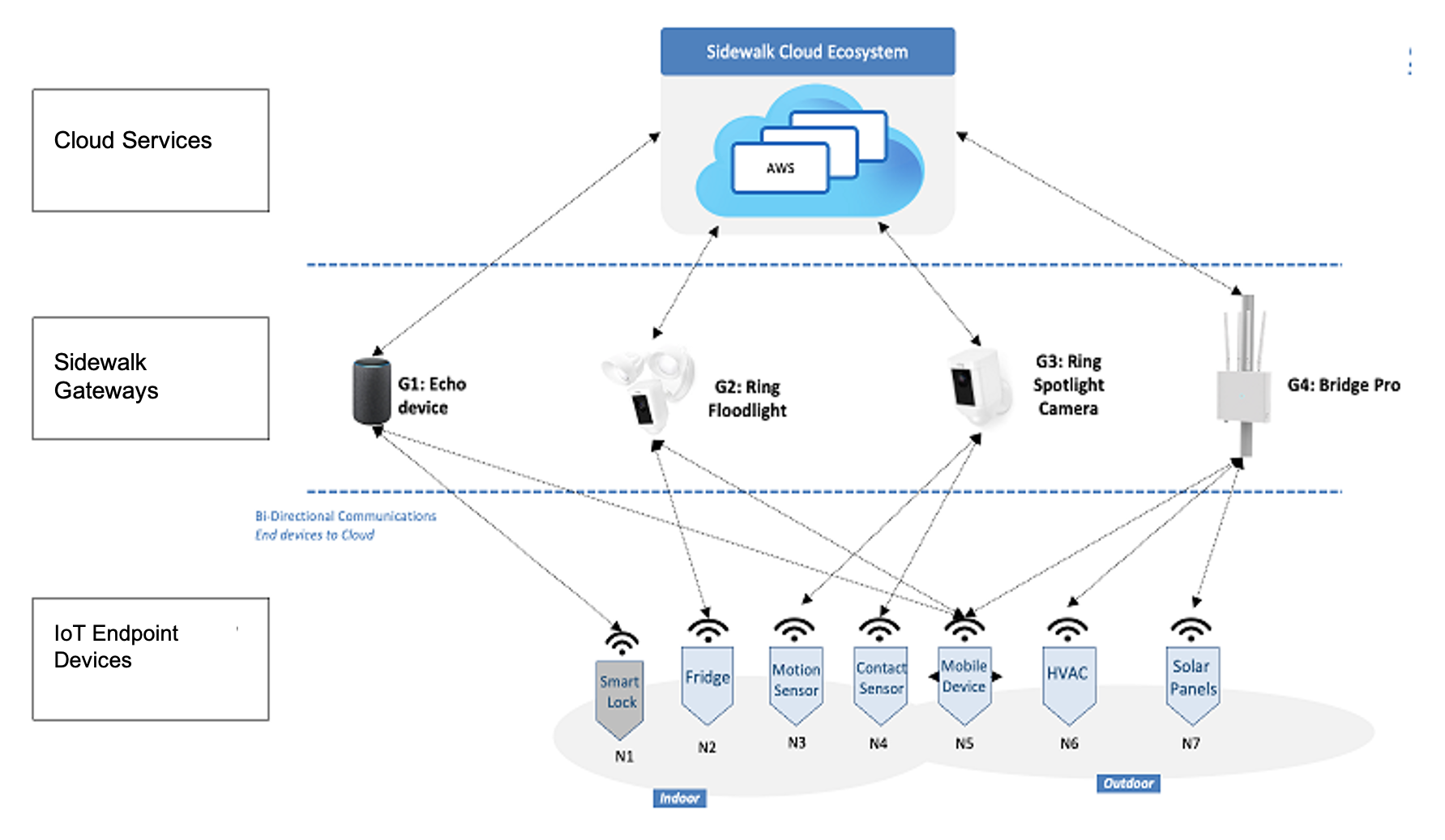How Amazon Sidewalk works
Eligible Amazon Echo and Ring devices can act as gateways (or Sidewalk bridges) and connect Sidewalk devices to the cloud. Certain Sidewalk Bridges such as the Echo Show 10 and the Ring Floodlight Cam have built-in sub-GHz LoRa or frequency-shift keying (FSK), which can accept signals from Sidewalk devices that are within a larger wireless range. A Sidewalk device (endpoint) can roam and automatically connect to any nearby Sidewalk Gateway. When the Sidewalk Gateway receives the signals from an endpoint device, it uses a small portion of the home network’s internet bandwidth to route the message received from the Sidewalk endpoint to the cloud, which further routes the message to the desired destination.
Amazon Sidewalk network architecture
The following diagram shows a simple overview of the Amazon Sidewalk network architecture. The Amazon Sidewalk network comprises millions of gateways and is designed to support billions of end devices. For more information about Amazon Sidewalk and Sidewalk-enabled devices, see the Amazon Sidewalk Webpage webpage.

Amazon Sidewalk limits
Amazon caps the amount of bandwidth shared to reduce the chances of any degradation in a customer’s home network performance. The maximum bandwidth of a Sidewalk Gateway to the Sidewalk Network Server is 80Kbps, which is about 1/40th of the bandwidth used to stream a typical high definition video. Today, total monthly data used by Sidewalk-enabled devices is capped at 500MB for one customer, which is equivalent to streaming about 10 minutes of high-definition video. For more information, please refer to the Amazon Sidewalk Privacy and Security whitepaper
The Amazon Sidewalk network was designed for the community benefit and targeting low power applications. For best performance, we recommend limiting the traffic rate of your devices when using any of the supported PHYs (Bluetooth LE, FSK or LoRa). For more information on the protocol design parameters, please look at the Amazon Sidewalk Protocol Specification
Sidewalk End Device Maximum Uplink Traffic Rates
The Amazon Sidewalk network enforces uplink maximum traffic rates for endpoints. These are the principles governing the traffic rate enforcement policy:
- End devices are categorized as either static (does not move) or mobile. Different rate thresholds apply.
- For Sub-1 GHz CSS there are two modes: normal and burst. Burst mode is not applicable for Bluetooth LE and FSK
- Traffic rates are checked daily
- Traffic in either normal or burst mode accrue towards a single maximum number of packets per day
Rates are summarized in the following table:
| PHY type | Static/Mobile | Normal mode rate | Burst mode rate | Max packet per day |
|---|---|---|---|---|
| Sub-1 GHz CSS | Static | 1 packet every 15 min | 1 packet every 5 min | 96 |
| Sub-1 GHz CSS | Mobile | 1 packet every 6 min | 1 packet every 1 min | 250 |
| FSK | Either static or mobile | 700 packets per min | Not applicable | 1,008,000 |
| Bluetooth LE | Either static or mobile | 600 packets per min | Not applicable | 864,000 |